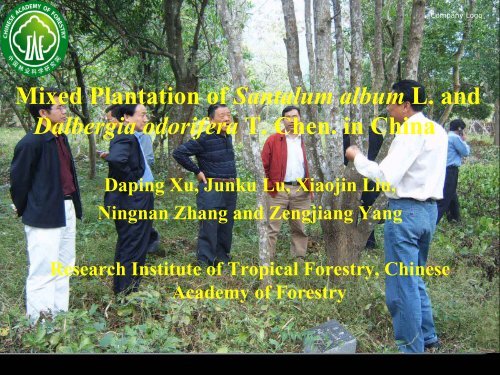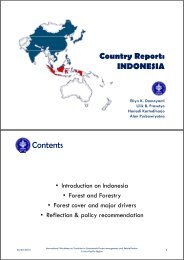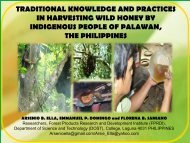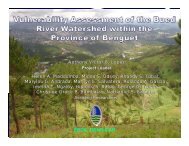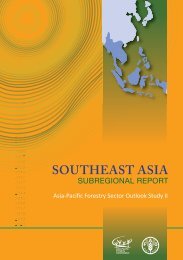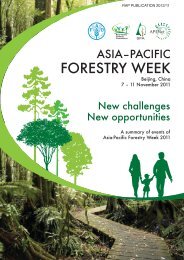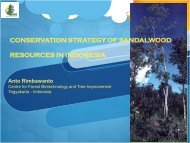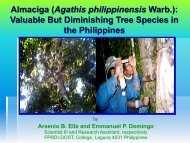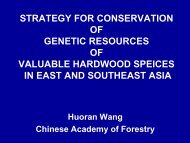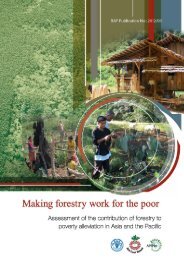Mixed Plantation of Santalum album L. and - APAFRI-Asia Pacific ...
Mixed Plantation of Santalum album L. and - APAFRI-Asia Pacific ...
Mixed Plantation of Santalum album L. and - APAFRI-Asia Pacific ...
You also want an ePaper? Increase the reach of your titles
YUMPU automatically turns print PDFs into web optimized ePapers that Google loves.
Company Logo<br />
<strong>Mixed</strong> <strong>Plantation</strong> <strong>of</strong> <strong>Santalum</strong> <strong>album</strong> L. <strong>and</strong><br />
Dalbergia odorifera T. Chen. in China<br />
Daping Xu, Junku Lu, Xiaojin Liu,<br />
Ningnan Zhang <strong>and</strong> Zengjiang Yang<br />
Research Institute <strong>of</strong> Tropical Forestry, Chinese<br />
Academy <strong>of</strong> Forestry
Introduction <strong>of</strong> S<strong>and</strong>alwood<br />
<strong>Santalum</strong> <strong>album</strong> L. was introduced into China in<br />
1962<br />
Establishing this species plantation has been<br />
started since 1980s’<br />
There are 1500 ha s<strong>and</strong>alwood plantations in<br />
China now, <strong>and</strong> most <strong>of</strong> them was established in<br />
the past 5 years<br />
It will reach to 5000 ha by 2015
Plus Tree Selection<br />
More than 40<br />
plus trees were<br />
selected from<br />
plantations<br />
according to<br />
the early<br />
growth. There<br />
is uncertainty<br />
on hard quality<br />
<strong>of</strong> those plus<br />
trees.
Seed Production<br />
Seed orchard was established with<br />
these selected plus tree seeds.<br />
The seeds were collected from former<br />
plantations. Seed production is more<br />
than enough for plantation<br />
establishment.<br />
We are very interested in genetic<br />
resource exchange. Please contact me<br />
if you are interested in seed exchange.
Seed storage <strong>and</strong> pre-treatment<br />
S<strong>and</strong>al seeds can keep a high vigor (40-<br />
50%) for 2-3 years when stored in a<br />
cold, dry environment at around 4 ℃ ;<br />
Low concentration <strong>of</strong> gibberellins<br />
(0.08%-0.12%) can accelerate the<br />
germination <strong>of</strong> s<strong>and</strong>al seeds greatly (Liu<br />
et al, 2010).<br />
Seedbed <strong>of</strong><br />
s<strong>and</strong>al after<br />
GA treatment
Seedling raising<br />
Beginning<br />
2 months later<br />
media affects growth <strong>and</strong> quality <strong>of</strong> s<strong>and</strong>al seedlings;<br />
burnt soil, peat <strong>and</strong> coconut dust (1:1:1) the best (Liu et al, 2009).<br />
4 months later 5 months later
Seedling Production<br />
A series <strong>of</strong> experiments had been done to determine the<br />
best seed treatment, media, host plant, fertilization<br />
regime <strong>and</strong> growth control for seedling production.
Seedling raising<br />
Using the best cultivation technique,<br />
s<strong>and</strong>al seedlings can be raised in<br />
larger amount, about 5 million per<br />
year in China;<br />
Therefore, the price <strong>of</strong> a seedling has<br />
been decreased dramatically from 5<br />
to 0.5 USD in past 5 years.<br />
S<strong>and</strong>al nursery<br />
S<strong>and</strong>al seedlings
Tissue Culture Seedlings have been<br />
tested for plantation establishment
Site selection<br />
S<strong>and</strong>alwood trees like to grow on good<br />
drainage condition, <strong>and</strong> hilly <strong>and</strong><br />
mountainous l<strong>and</strong>s are better than<br />
plain l<strong>and</strong>s.<br />
Young trees can tolerate -2 o C in 2-3<br />
days with a little drying up <strong>of</strong> young<br />
leaves <strong>and</strong> tips in winter<br />
It is more likely that hard formation<br />
will be earlier in tropical than<br />
subtropical climate
Pest control<br />
Pests can be divided into two groups: leaf eating <strong>and</strong> stem boring.<br />
Leaf eating insects (moths) can be controlled by Trichlorfon.<br />
Boring insects can be controlled by stem injection <strong>of</strong> Dichlorvos.
Disease control<br />
Disease control during nursery period<br />
was critical for s<strong>and</strong>al;<br />
Thiophanate-methyl, Carbendazol <strong>and</strong><br />
Triadimefon are useful for controlling<br />
s<strong>and</strong>al diseases;<br />
No spike disease was found in China.<br />
Shoot wilting<br />
Stem blight<br />
Powdery mildew
Tending <strong>and</strong> management<br />
Water management, nutrient supply <strong>and</strong><br />
host maintenance are three most important<br />
factors during the tending or management<br />
<strong>of</strong> s<strong>and</strong>al;<br />
Water redundant <strong>and</strong> host death cause leaf<br />
etiolation, while micro-nutrient deficiency<br />
cause top wilt.<br />
Water redundant<br />
Lost host<br />
Nutrient deficiency
<strong>Plantation</strong> establishment<br />
S<strong>and</strong>al plantations grow very well in<br />
Guangdong province, especially with<br />
mixed hosts;<br />
An average height <strong>of</strong> 6.05m <strong>and</strong> 10.27<br />
cm DBH were achieved in 6-year old<br />
s<strong>and</strong>al plantations (Liu et al, 2012).<br />
Field establishment 1 year old 2 years old 6 years old
Kuhnia rosmarnifolia from seedling<br />
pot can be a good host for 1-2 years
White Tephrosia (Tephrosia c<strong>and</strong>ida) is good host when<br />
Kuhnia rosmarnifolia is shaded by s<strong>and</strong>alwood trees
Young tree stage<br />
Kuhnia rosmarnifolia<br />
Tephrosia c<strong>and</strong>ida<br />
Different hosts affect the growth, Kuhnia rosmarnifolia is the most<br />
suitable pot host, <strong>and</strong> tephrosia c<strong>and</strong>ida is the best intermediate host<br />
(Liu et al, 2010).
Irrigation will be helpful on hilly side
Long Term host is Dalbergia odorifera, the best<br />
rosewood in the world for a mixed forest<br />
between s<strong>and</strong>wood <strong>and</strong> Dalbergia odorifera
Site selection<br />
S<strong>and</strong>al also grows well in four-side &<br />
roadside <strong>and</strong> ornamental planting.<br />
Four-side planting Roadside planting Ornamental planting
Heartwood presences in<br />
young s<strong>and</strong>al<br />
Total ion chromatogram <strong>of</strong> essential oil<br />
extracted from 6-year-old young s<strong>and</strong>al<br />
Cores taken from different heights within a tree<br />
α-santalol, 18.62%<br />
β-santalol, 9.82%<br />
Heartwood commence to form naturally at an early year (6-year old) in China,<br />
but the santalol content is low (Liu et al, 2011, 2012).
In a 20 years old plantation, all trees<br />
have hardwood in Hainan isl<strong>and</strong>
Speed heartwood formation<br />
A series <strong>of</strong> experiments were conducted in<br />
last year strive to accelerate heartwood<br />
formation in young s<strong>and</strong>als;<br />
Those approaches include: gas stress,<br />
wounding stress, phytoharmone stress <strong>and</strong><br />
fungi stress etc.<br />
Stem injection Gas filling Fungi injection
Cores <strong>and</strong> oil extracted from different treatments<br />
Ion chromatogram <strong>of</strong> oil<br />
Speed heartwood formation<br />
Different gases have different effects in<br />
inducing heartwood formation <strong>of</strong> young<br />
s<strong>and</strong>al;<br />
Great differences in heartwood distribution,<br />
oil yield <strong>and</strong> oil quality were found between<br />
different gas treatments (Liu et al,<br />
unpublished data).<br />
Component<br />
Content<br />
α-santalol 38.49%<br />
β-santalol 10.41%
Speed heartwood formation<br />
Different kinds <strong>and</strong> dosage <strong>of</strong><br />
phytoharmones affect the heartwood<br />
formation, oil content as well as oil<br />
quality <strong>of</strong> s<strong>and</strong>al significantly (Liu et<br />
al, unpublished data).<br />
Component Content<br />
α-santalol 38.23%<br />
β-santalol 18.71%<br />
Component Content<br />
α-santalol 20.42%<br />
β-santalol 8.06%<br />
Core samples <strong>of</strong> induced heartwood<br />
Total ion chromatogram <strong>of</strong> induced oil
Speed heartwood formation<br />
Fungi can also induce heartwood<br />
formation in young s<strong>and</strong>als;<br />
Oil content <strong>and</strong> quality induced by<br />
different fungis are under<br />
determination.
Company Logo<br />
Why is Dalbergia odorifera a superior host<br />
<strong>of</strong> s<strong>and</strong>alwood ?
S<strong>and</strong>alwood growth performance with different hosts <strong>and</strong><br />
no host treatment<br />
Company Logo<br />
S<strong>and</strong>alwood associated with Dalbergia odorifera<br />
S<strong>and</strong>alwood associated with Acacaia confusa
Company Logo<br />
S<strong>and</strong>alwood associated with<br />
Bisch<strong>of</strong>ia polycarpa<br />
S<strong>and</strong>alwood associated<br />
with Dracontomelon<br />
duperreranum<br />
No host s<strong>and</strong>alwood
D. odorifera was the best host for s<strong>and</strong>alwood<br />
growth comparing with other 3 host <strong>and</strong> no host.<br />
Company Logo
Haustorium <strong>of</strong> S. <strong>album</strong> attaching on the host root <strong>and</strong><br />
nodule<br />
Company Logo
N% in s<strong>and</strong>alwood were greater when growing<br />
with two N 2 -fixing hosts than with two non-<br />
N 2 -fixing hosts or with no host<br />
Company Logo
δ 15 N is significantly greater in the S. <strong>album</strong> if grew alone or<br />
grew with non -N 2 -fixing hosts than grew with N 2 -fixing hosts<br />
Company Logo
Company Logo<br />
Rhizobium inoculation enhanced N transfer from D. odorifera to S.<br />
<strong>album</strong> via haustoria connection using 15 N tracer
Photosynthesis rate was highest when s<strong>and</strong>alwood growing<br />
with D. odorifera in the 190 days after transplanting<br />
Company Logo
ABA content in s<strong>and</strong>alwood leaves was higher than other host<br />
species<br />
Company Logo<br />
Content <strong>of</strong> ABA in plant leaves <strong>of</strong> <strong>Santalum</strong> <strong>album</strong> associated with<br />
different hosts
The content <strong>of</strong> ABA in hosts was increased after their<br />
setting up semi-parasitic relationship<br />
Company Logo<br />
Content <strong>of</strong> ABA in plant leaves<br />
(ng/g· FW)
Company Logo<br />
In next decade, 10000 ha mixed<br />
plantation <strong>of</strong> <strong>Santalum</strong> <strong>album</strong> L. <strong>and</strong><br />
Dalbergia odorifera T. Chen. will be<br />
established in south China<br />
Thank!


